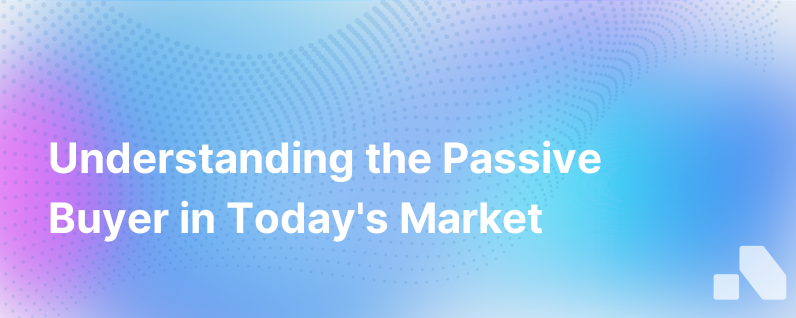
In the ever-expanding universe of sales and marketing, the term "passive buyer" is becoming increasingly significant. It represents a segment of potential customers who are not actively seeking out new products or solutions but may be persuaded to buy if approached with the right strategy. Understanding the nuances of a passive buyer is essential for B2B companies; it's the difference between a missed opportunity and a strategic win.
The Passive Buyer Persona
A passive buyer is someone who may have a latent need for a product or service but is not actively looking for a solution. They may be content with their current situation or unaware that a better solution exists. This lack of urgency means they're not engaged in the buying process and are not likely to respond to hard-sell tactics.
Unlike active buyers, who are already searching for solutions, passive buyers require a different approach. They are not poring over product reviews, attending trade shows, or requesting demos. They represent the silent majority of the market – potential customers who only become visible when you reach out to them in a meaningful way.
Identifying Passive Buyers
Passive buyers can be found across various channels but are often invisible because they're not taking action. They may include businesses that are using outdated or legacy systems, industries resistant to change, or contacts within an organization who are not directly involved with procurement. Identifying them requires a combination of market research, customer insights, and perhaps predictive analytics to determine potential needs.
To target passive buyers effectively, companies must focus on indirect signals of interest or opportunity, such as:
- Organizational changes that could trigger a need for new solutions
- Industry trends that indicate a market shift
- Regulatory changes that necessitate new compliance tools
Knowing where to find passive buyers is like understanding the hidden part of an iceberg. It's the broader, unseen market potential that lies beneath the surface of your active leads.
Engaging with Passive Buyers
Approaching passive buyers requires a thoughtful, value-first strategy. The focus should be on education and engagement rather than immediate sales. Content marketing plays a key role here; by providing valuable insights and information, you can raise awareness of issues the buyer may not have considered and position your product as the solution.
Effective tactics to engage passive buyers might include:
- Thought leadership articles on relevant industry pains
- Whitepapers detailing the benefits of new technological advancements
- Case studies showcasing how similar companies have achieved success with your product
- Educational webinars on topical challenges facing their industry
It’s essential to nurture a relationship with passive buyers over time, building trust and positioning your brand as a knowledgeable authority in the space.
Converting Passive Buyers into Active Buyers
The journey of converting a passive buyer into an active one hinges on creating awareness and fostering a realization of need. This process might begin with the prospect absorbing educational content and evolve through a series of interactions, such as:
- Engaging with an informative blog post
- Downloading a whitepaper
- Attending a webinar
- Receiving a tailored email based on their expressed interests
Throughout this journey, sales enablement and marketing teams must work together to deliver consistent, unified messaging that speaks to the passive buyer's unique context.
Challenges in Targeting Passive Buyers
The art of swaying passive buyers is intricate and marked by challenges:
- The long sales cycle, as trust and awareness are built gradually
- Difficulty in identifying passive buyers, since they’re not self-declared
- Balancing the content tone, which should be educational without being too sales-focused
- Avoiding outreach fatigue, despite the long nurturing period
Given these complexities, companies often require robust analytics and CRM tools to manage the lifecycle of passive buyer engagement.
Transitioning Passive Buyers with AI
In leveraging technological advancements, specifically AI, tedious tasks associated with identifying and nurturing passive buyers can be optimized. AI platforms can analyze vast quantities of data to spot trends and signal purchase intent. It can also automate personalized content delivery, maintaining relevance and engagement over time.
AI solutions, particularly in the realm of B2B sales like Aomni, help in delivering actionable competitive insights. By understanding how similar accounts have moved from passive to active stages, sales teams can fine-tune their approaches. Zero-effort solutions use real-time account research to systematically engage passive buyers with personalized content, converting them from cold leads to warm prospects and eventually, active customers.
Value of Passive Buyers
Despite the challenges, passive buyers are valuable. They represent untapped potential and an opportunity to expand market share quietly. Successful engagement with passive buyers not only results in new customers but can also create loyal advocates for your solutions. The knowledge you gain from interacting with passive buyers enriches your understanding of the market and helps to refine your offerings.
In sum, passive buyers are an essential segment for B2B companies seeking a holistic and strategic approach to growth. They may not be the low-hanging fruit, but with the right engagement strategy, they can yield a bountiful harvest. Truly adept companies will leverage AI tools like Aomni to transform the landscape of passive buyer engagement – ensuring that they don't just reach more customers, but the right customers at the right time.